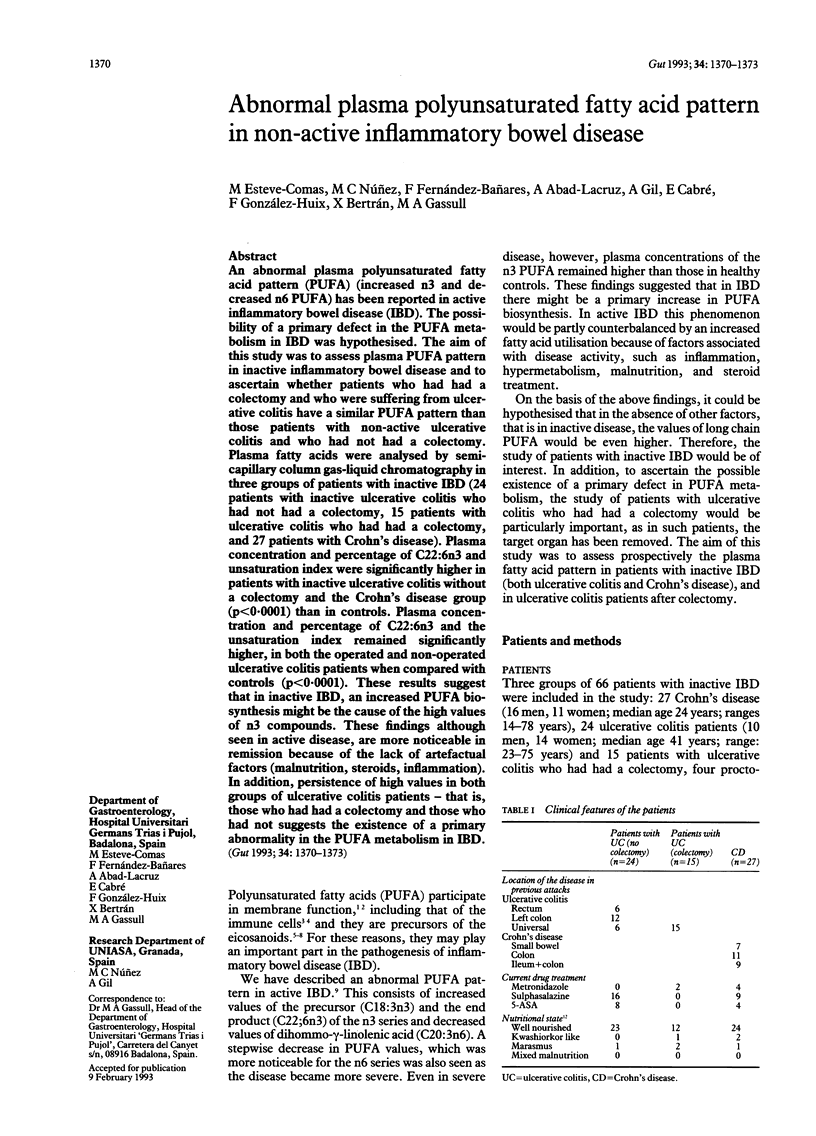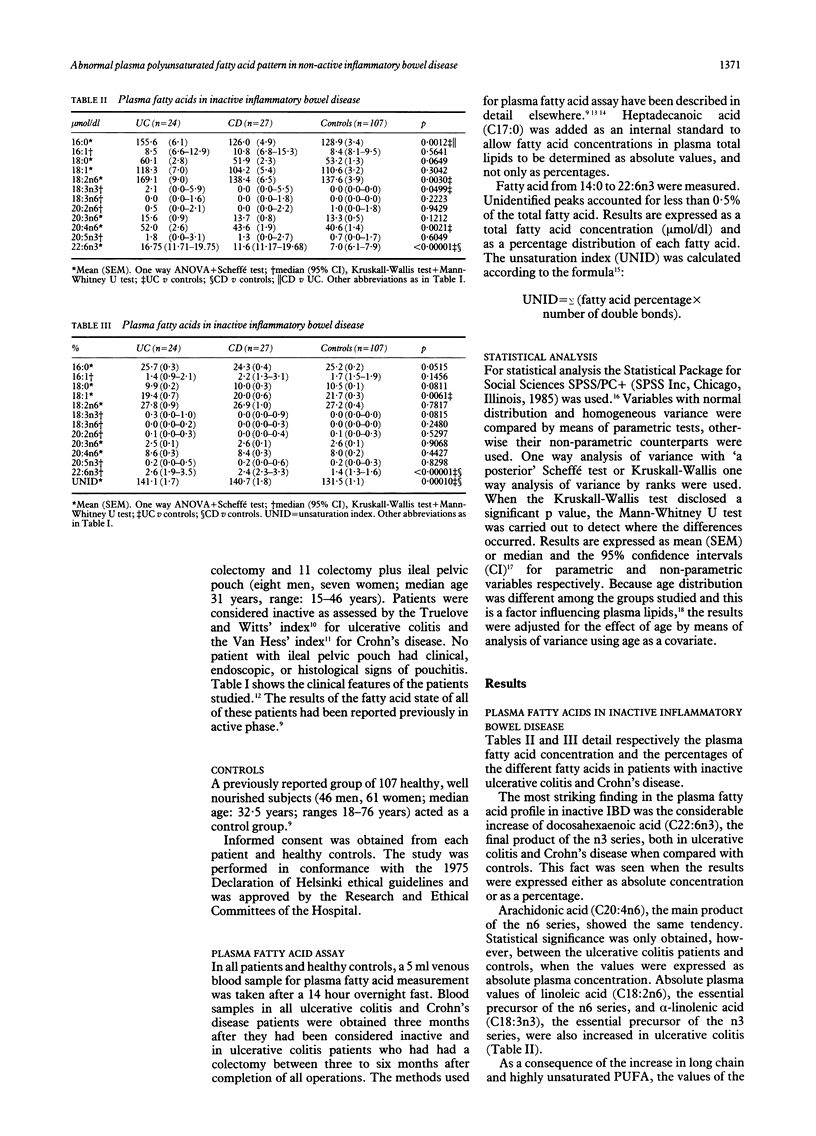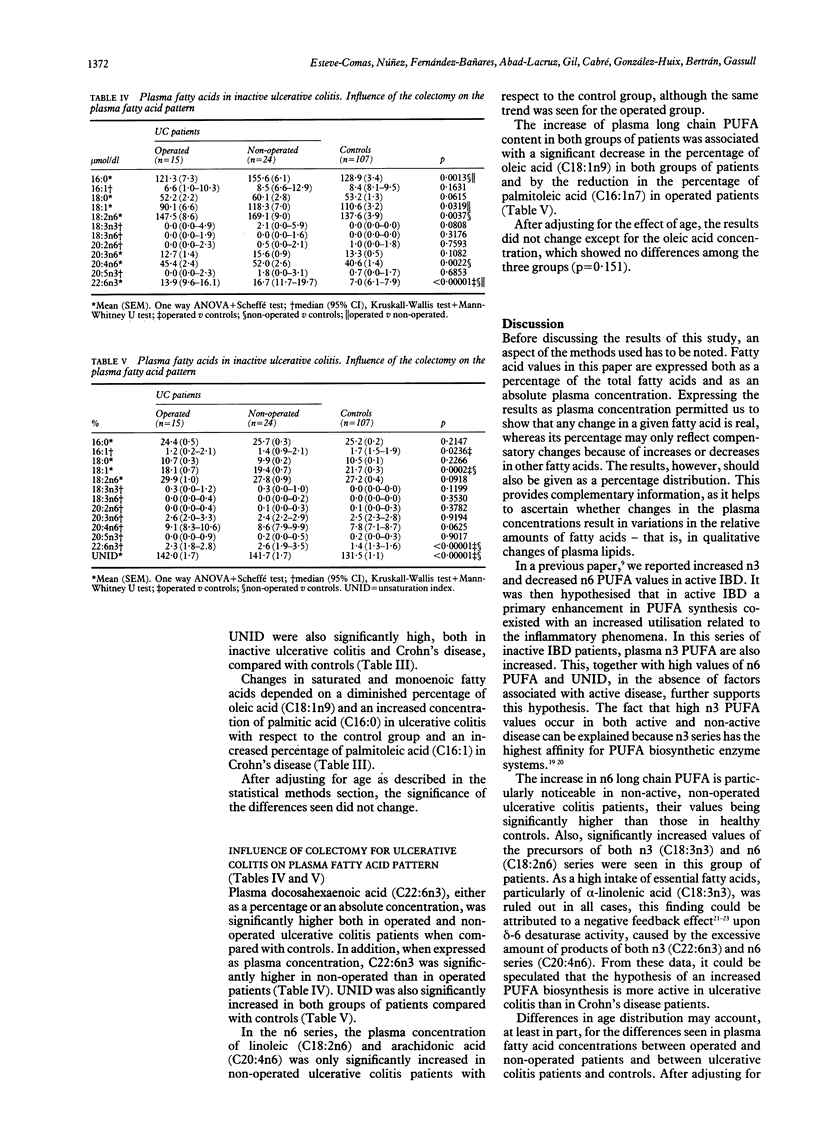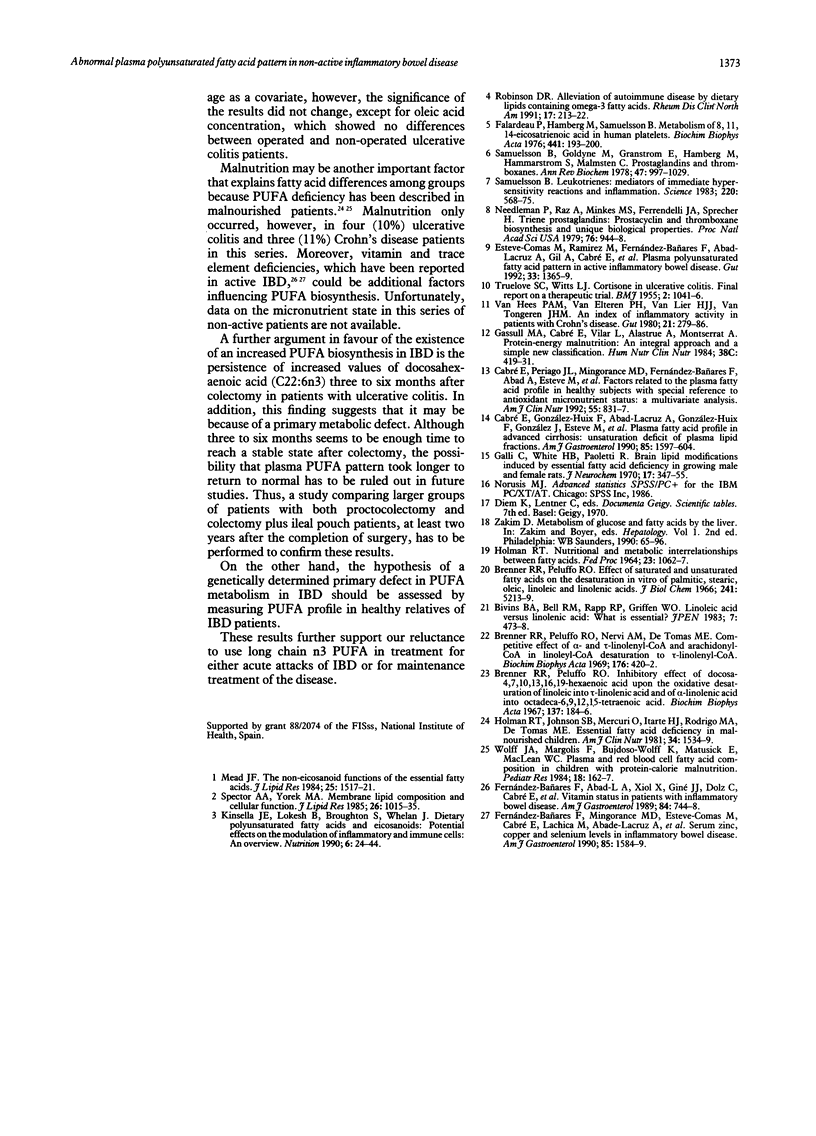Abstract
An abnormal plasma polyunsaturated fatty acid pattern (PUFA) (increased n3 and decreased n6 PUFA) has been reported in active inflammatory bowel disease (IBD). The possibility of a primary defect in the PUFA metabolism in IBD was hypothesised. The aim of this study was to assess plasma PUFA pattern in inactive inflammatory bowel disease and to ascertain whether patients who had had a colectomy and who were suffering from ulcerative colitis have a similar PUFA pattern than those patients with non-active ulcerative colitis and who had not had a colectomy. Plasma fatty acids were analysed by semi-capillary column gas-liquid chromatography in three groups of patients with inactive IBD (24 patients with inactive ulcerative colitis who had not had a colectomy, 15 patients with ulcerative colitis who had had a colectomy, and 27 patients with Crohn's disease). Plasma concentration and percentage of C22:6n3 and unsaturation index were significantly higher in patients with inactive ulcerative colitis without a colectomy and the Crohn's disease group (p < 0.0001) than in controls. Plasma concentration and percentage of C22:6n3 and the unsaturation index remained significantly higher, in both the operated and non-operated ulcerative colitis patients when compared with controls (p < 0.0001). These results suggest that in inactive IBD, an increased PUFA biosynthesis might be the cause of the high values of n3 compounds. These findings although seen in active disease, are more noticeable in remission because of the lack of artefactual factors (malnutrition, steroids, inflammation). In addition, persistence of high values in both groups of ulcerative colitis patients--that is, those who had had a colectomy and those who had not suggests the existence of a primary abnormality in the PUFA metabolism in IBD.
Full text
PDF



Selected References
These references are in PubMed. This may not be the complete list of references from this article.
- Bivins B. A., Bell R. M., Rapp R. P., Griffen W. O., Jr Linoleic acid versus linolenic acid: what is essential? JPEN J Parenter Enteral Nutr. 1983 Sep-Oct;7(5):473–478. doi: 10.1177/0148607183007005473. [DOI] [PubMed] [Google Scholar]
- Brenner R. R., Peluffo R. O. Effect of saturated and unsaturated fatty acids on the desaturation in vitro of palmitic, stearic, oleic, linoleic, and linolenic acids. J Biol Chem. 1966 Nov 25;241(22):5213–5219. [PubMed] [Google Scholar]
- Brenner R. R., Peluffo R. O. Inhibitory effect of docosa-4,7,10,13,16,19-hexaenoic acid upon the oxidative desaturation of linoleic into gamma-linolenic acid and of alpha-linolenic into octadeca-6,9,12,15-tetraenoic acid. Biochim Biophys Acta. 1967 Feb 14;137(1):184–186. doi: 10.1016/0005-2760(67)90024-0. [DOI] [PubMed] [Google Scholar]
- Cabré E., Periago J. L., Abad-Lacruz A., González-Huix F., González J., Esteve-Comas M., Fernández-Bañares F., Planas R., Gil A., Sánchez-Medina F. Plasma fatty acid profile in advanced cirrhosis: unsaturation deficit of lipid fractions. Am J Gastroenterol. 1990 Dec;85(12):1597–1604. [PubMed] [Google Scholar]
- Cabré E., Periago J. L., Mingorance M. D., Fernández-Bañares F., Abad A., Esteve M., Gil A., Lachica M., González-Huix F., Gassull M. A. Factors related to the plasma fatty acid profile in healthy subjects, with special reference to antioxidant micronutrient status: a multivariate analysis. Am J Clin Nutr. 1992 Apr;55(4):831–837. doi: 10.1093/ajcn/55.4.831. [DOI] [PubMed] [Google Scholar]
- Esteve-Comas M., Ramírez M., Fernández-Bañares F., Abad-Lacruz A., Gil A., Cabré E., González-Huix F., Moreno J., Humbert P., Guilera M. Plasma polyunsaturated fatty acid pattern in active inflammatory bowel disease. Gut. 1992 Oct;33(10):1365–1369. doi: 10.1136/gut.33.10.1365. [DOI] [PMC free article] [PubMed] [Google Scholar]
- Falardeau P., Hamberg M., Samuelsson B. Metabolism of 8,11,14-eicosatrienoic acid in human platelets. Biochim Biophys Acta. 1976 Aug 23;441(2):193–200. doi: 10.1016/0005-2760(76)90162-4. [DOI] [PubMed] [Google Scholar]
- Fernandez-Banares F., Abad-Lacruz A., Xiol X., Gine J. J., Dolz C., Cabre E., Esteve M., Gonzalez-Huix F., Gassull M. A. Vitamin status in patients with inflammatory bowel disease. Am J Gastroenterol. 1989 Jul;84(7):744–748. [PubMed] [Google Scholar]
- Fernández-Bañares F., Mingorance M. D., Esteve M., Cabré E., Lachica M., Abad-Lacruz A., Gil A., Humbert P., Boix J., Gassull M. A. Serum zinc, copper, and selenium levels in inflammatory bowel disease: effect of total enteral nutrition on trace element status. Am J Gastroenterol. 1990 Dec;85(12):1584–1589. [PubMed] [Google Scholar]
- Galli C., White H. B., Jr, Paoletti R. Brain lipid modifications induced by essential fatty acid deficiency in growing male and female rats. J Neurochem. 1970 Mar;17(3):347–355. doi: 10.1111/j.1471-4159.1970.tb02221.x. [DOI] [PubMed] [Google Scholar]
- Gassull M. A., Cabré E., Vilar L., Alastrue A., Montserrat A. Protein-energy malnutrition: an integral approach and a simple new classification. Hum Nutr Clin Nutr. 1984 Nov;38(6):419–431. [PubMed] [Google Scholar]
- HOLMAN R. T. NUTRITIONAL AND METABOLIC INTERRELATIONSHIPS BETWEEN FATTY ACIDS. Fed Proc. 1964 Sep-Oct;23:1062–1067. [PubMed] [Google Scholar]
- Holman R. T., Johnson S. B., Mercuri O., Itarte H. J., Rodrigo M. A., De Tomas M. E. Essential fatty acid deficiency in malnourished children. Am J Clin Nutr. 1981 Aug;34(8):1534–1539. doi: 10.1093/ajcn/34.8.1534. [DOI] [PubMed] [Google Scholar]
- Kinsella J. E., Lokesh B., Broughton S., Whelan J. Dietary polyunsaturated fatty acids and eicosanoids: potential effects on the modulation of inflammatory and immune cells: an overview. Nutrition. 1990 Jan-Feb;6(1):24–62. [PubMed] [Google Scholar]
- Mead J. F. The non-eicosanoid functions of the essential fatty acids. J Lipid Res. 1984 Dec 15;25(13):1517–1521. [PubMed] [Google Scholar]
- Needleman P., Raz A., Minkes M. S., Ferrendelli J. A., Sprecher H. Triene prostaglandins: prostacyclin and thromboxane biosynthesis and unique biological properties. Proc Natl Acad Sci U S A. 1979 Feb;76(2):944–948. doi: 10.1073/pnas.76.2.944. [DOI] [PMC free article] [PubMed] [Google Scholar]
- Robinson D. R. Alleviation of autoimmune disease by dietary lipids containing omega-3 fatty acids. Rheum Dis Clin North Am. 1991 May;17(2):213–222. [PubMed] [Google Scholar]
- Samuelsson B., Goldyne M., Granström E., Hamberg M., Hammarström S., Malmsten C. Prostaglandins and thromboxanes. Annu Rev Biochem. 1978;47:997–1029. doi: 10.1146/annurev.bi.47.070178.005025. [DOI] [PubMed] [Google Scholar]
- Samuelsson B. Leukotrienes: mediators of immediate hypersensitivity reactions and inflammation. Science. 1983 May 6;220(4597):568–575. doi: 10.1126/science.6301011. [DOI] [PubMed] [Google Scholar]
- Spector A. A., Yorek M. A. Membrane lipid composition and cellular function. J Lipid Res. 1985 Sep;26(9):1015–1035. [PubMed] [Google Scholar]
- TRUELOVE S. C., WITTS L. J. Cortisone in ulcerative colitis; final report on a therapeutic trial. Br Med J. 1955 Oct 29;2(4947):1041–1048. doi: 10.1136/bmj.2.4947.1041. [DOI] [PMC free article] [PubMed] [Google Scholar]
- Wolff J. A., Margolis S., Bujdoso-Wolff K., Matusick E., MacLean W. C., Jr Plasma and red blood cell fatty acid composition in children with protein-calorie malnutrition. Pediatr Res. 1984 Feb;18(2):162–167. doi: 10.1203/00006450-198402000-00010. [DOI] [PubMed] [Google Scholar]
- van Hees P. A., van Elteren P. H., van Lier H. J., van Tongeren J. H. An index of inflammatory activity in patients with Crohn's disease. Gut. 1980 Apr;21(4):279–286. doi: 10.1136/gut.21.4.279. [DOI] [PMC free article] [PubMed] [Google Scholar]


